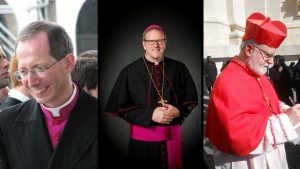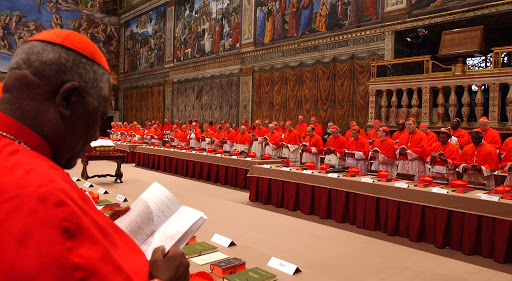One of the most interesting levels of hierarchy in the Catholic Church is that of the rank of “cardinal.” It is a rank that has changed over the centuries and has some fascinating origins.
According to the Catholic Encyclopedia, “By the term cardinal (cardinalis) was originally understood every priest permanently attached to a church … It became the usual designation of every priest belonging to a central or episcopal church.” The Latin root of the word is cardo, meaning “hinge,” and reflects their pivotal role in the original formation of the Church. We hear an echo of this root today in the fact that every parish priest must be incardinated into, or officially attached to, a diocese.
Especially in Rome, the first “cardinals” were priests assigned to specific regions/churches within the city. This term was also extended to deacons who assisted these priests in Rome, “For the care of the poor the city was divided into seven regions, each of which was administered by a deacon.”
As the centuries progressed, the pope was in need of more help in administering the growing Church and appointed certain regional bishops to be cardinals. These cardinals would be appointed in strategic locations and would often travel to Rome as a local representative to help the pope in making important decisions.
This particular role of the cardinal has been maintained ever since and is reflected in the following description in the Code of Canon Law.
Can. 349 The cardinals of the Holy Roman Church constitute a special college which provides for the election of the Roman Pontiff according to the norm of special law. The cardinals assist the Roman Pontiff either collegially when they are convoked to deal with questions of major importance, or individually when they help the Roman Pontiff through the various offices they perform, especially in the daily care of the universal Church.
One of the major roles of cardinals since the 12th century, as is noted above, has been the election of a new pope. Today, the exercise of this role is limited to cardinals who have not reached their 80th birthday by the day the papacy is vacated.
While most cardinals are bishops, the pope is free to appoint anyone who has been ordained a priest to become a cardinal, as it is stated in the current Code of Canon Law.
Can. 351 §1. The Roman Pontiff freely selects men to be promoted as cardinals, who have been ordained at least into the order of the presbyterate and are especially outstanding in doctrine, morals, piety, and prudence in action; those who are not yet bishops must receive episcopal consecration.
Up until 1917 some cardinals, like St. John Henry Newman, were appointed while only priests, and never became bishops as is the current practice. However, there are some modern exceptions, such as Cardinal Avery Dulles, who was a Jesuit priest and named a cardinal in 2001 by Pope John Paul II. He was never ordained a bishop and was a cardinal while staying a priest.
This simply highlights the reality that the title of “cardinal” is exactly that, a “title” and not a separate ordination. Similarly, the title can be revoked and the cleric would then resume his regular duties, no longer permitted to be one of the pope’s closest advisors.
In the end, a cardinal is one who is willing to assist the pope in guiding the Church no matter what the cost. The pope says the following prayer to remind the cardinal of his duties, which are reflected in the scarlet color they use.
(This is) scarlet as a sign of the dignity of the cardinalate, signifying your readiness to act with courage, even to the shedding of your blood, for the increase of the Christian faith, for the peace and tranquility of the people of God and for the freedom and growth of Holy Roman Church.

Read more:
How to tell the difference between a monsignor, a bishop and a cardinal

Read more:
What is a monsignor in the Catholic Church?

